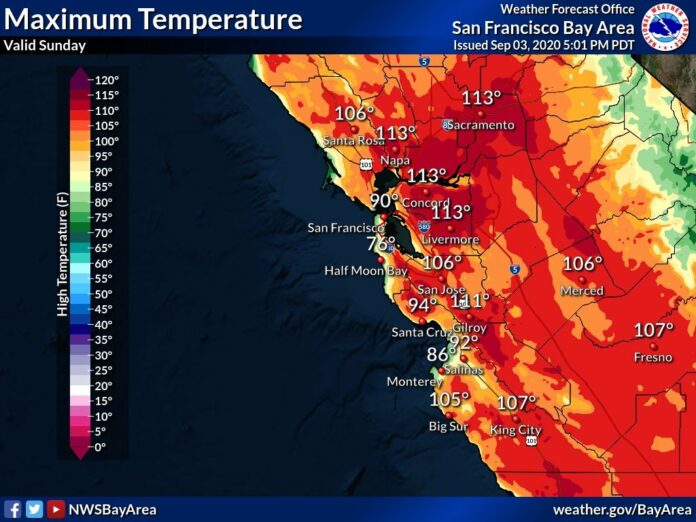Have you ever been to Phoenix, Arizona in the summer? It’s about to come to you.
A heat wave is poised to break records across the Bay Area and much of the rest of California over Labor Day Weekend, starting Saturday and peaking Sunday with temperatures forecast to exceed 110 degrees in some areas.
In Gilroy, the forecast Sunday is for 112 degrees, the same temperature as is forecast for Phoenix that day, according to the National Weather Service. Livermore and Walnut Creek are expected to see 111 degrees Sunday, with San Jose a relatively balmy 102 — which would break the record of 100 set in 1923 — and Oakland expected to hit 95, which would tie a record set in 1979.
“These should be the hottest temperatures of the year so far,” said David King, a meteorologist with the National Weather Service in Monterey.
As if the Bay Area needed another headache, the National Weather Service on Friday issued a “fire weather watch” for the East Bay Hills and North Bay Hills for Monday night at 10 p.m. through Wednesday morning at 8 a.m. With low humidity levels, hot, dry winds are forecast to blow toward the ocean from Utah and Nevada, reaching up to 45 mph at higher elevations and spiking fire risk from San Luis Reservoir near Los Banos to Santa Rosa, particularly on Tuesday.
It will be the first “fire weather watch” this summer in the Bay Area based on winds. A more severe “red flag warning,” was issued Aug.15 before the freak lightning storms which set off dozens of fires around Northern California. Another was issued Aug. 22 but cancelled.
“Right now it’s just a watch, but we are going to be keeping our eye on it,” King said.

Of most immediate concern, however, was the heat wave.
The National Weather Service has issued an excessive heat warning from 11 a.m. Saturday to 9 p.m. Monday.
The forecast calls for coastal areas to see temperatures in the mid 80s to upper 90s around the Greater Bay Area, with temperatures reaching 110 degrees in interior locations and up to 115 degrees in some parts of the Diablo Range, Central Valley and eastern Bay Area.
“If you have to go outside, stay in the shade. Stay hydrated,” King said. “Check up on young children and senior citizens. These are dangerous temperatures that can cause health problems like heat exhaustion and heat stroke.”
Experts also say it’s critical to not leave children or pets in vehicles, and to watch for hot pavement while walking dogs.
California’s power grid operators have asked residents over the weekend to conserve electricity by cooling their homes in the morning and keeping air conditioning to 78 degrees or higher from 3 p.m. to 9 p.m. when electricity demand is highest around the state. They also ask residents to delay using major appliances like washers, dryers or dishwashers, during those hours.
“We’ll need help,” said Eric Schmitt, vice president of the California Independent System Operator, the non-profit entity which operates the state’s power grid.
Although the ISO does not expect rolling blackouts like there were Aug. 14 and Aug. 15 in some parts of the Bay Area, that could change if power plants suffer unexpected breakdowns or new fires take out transmission lines, he said.
“We expect above normal temps above California and therefore heavy loads,” Schmitt said. “We’re trying to alert the public and solicit conservation measures.”
Grid operators have worked to import more power from out of state to cover the crunch time in the early evening when solar farms around the state stop producing power as the sun goes down and demand remains high in heat waves. State rules require companies to construct battery storage projects to store an increasing amount of that electricity, but it will be several years before enough is built to make a major difference.
Meanwhile, California Gov. Gavin Newsom late Thursday issued an emergency order to help reduce the risk of blackouts. It relaxes various environmental rules over the weekend, including rules that require large commercial ships at Oakland, Long Beach, San Francisco and other ports to turn off their huge diesel engines and plug into the power grid. Those rules, which took effect in 2014, are designed to reduce soot and other air pollution, particularly in low-income neighborhoods near ports where there are high levels of asthma, emphysema and other respiratory ailments.
Newsom’s order also temporarily waives rules that would limit factories and other industrial sites from running their large portable generators due to pollution concerns. Those generators are usually used for emergencies only and are often high-polluting engines. But running them instead of drawing electricity from the grid reduces demand on the grid.
Smoke from the wildfires will remain in the Bay Area over the weekend.
Currently, three of the four largest wildfires in California history are all burning at the same time in Northern California. They are the SCU Complex Fire in the Diablo Range, the LNU Complex Fire in the North Bay and the August Complex Fire in the Mendocino National Forest.
Firefighters have made major progress on them. The SCU fire was 82% contained on Friday morning at 396,624 acres. The LNU fire was 87% contained at 375,209 acres. And the August fire was 23% contained at 298,629 acres. But the lack of winds and hot conditions over the weekend mean that the smoke will linger, forecasters said.
The winds that are expected to arrive Monday night will blow the smoke out to sea. But they will increase the risk of a new round of disasters.
“We are going to be very concerned about new fire starts that could happen with those winds,” King said.






